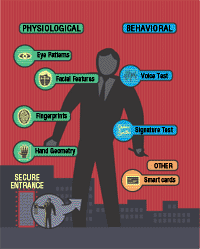Multimodal Biometrics Beef Up Security
Effective IT security is in high demand, and a large variety of industries such as banking, government, education, health care and the military view biometrics solutions as a key part of the solution.
Biometrics solutions analyze human characteristics for security, authentication and identification purposes and can be separated into two classifications: behavioral characteristics and physiological characteristics. Most work environments use some type of behavioral biometrics, such as ID badges/smart cards, passwords, PINs and tests of voice and signature. Physiological biometrics tests such as hand geometry, eye patterns and facial features are not as commonly used.

\
VINCENT A.
RANDAZZESE
\
Asst. Technical Editor
Behavioral biometrics are usually the first to be deployed because of their lower cost and easier setup, but they are prone to security problems such as user error or sharing cards and passwords. Adding physiological biometrics security to existing behavioral biometrics deployments will help create a secure, multimodal biometrics solution.
Biometrics identity management firm Wired Technology Systems is leading the charge with this two-pronged biometrics approach. "The real challenge here is taking the technology and transforming it into a useful platform, which can be applied into today's business practices," said Wired CEO John Nardolilli.
The West Palm Beach, Fla.-based company works most often with banking institutions and other large-scale deployments. The company was formed as a security center in 1987, concentrating on identity theft and security issues. Wired developed an authentication management infrastructure called WICAM (Wired Centralized Authentication Management Suite), which combines a full-scale deployment of both physiological and behavior biometrics.
The company takes a vendor-agnostic and completely customizable approach to its deployments and has the ability to implement a totally flexible, policy-driven approach to authentication and authorizations.
"Most companies need a method of facilitating the science. They need a reliable foundation that works. One device is not going to cut it, but the combination of the two with a strong stable infrastructure, which we create, will offer that next level of security," Nardolilli said.
Wired provides the added security through a variety of biometrics tests.
"We begin the process by taking information, such as Social Security numbers and passwords, and then apply it using third-party information, such as hand geometry, retinal patterns, keystroke dynamics, signatures, voice patterns and iris patterns. From there, we create a platform through diligence to accept [the users] as who or what they are,a complete identity audit."

\
Although multimodal biometrics solutions, which combine behavioral and physiological tests, are still in their infancy, it is only a matter of time before both verification and identification are the standard and are implemented in all business practices to add security.
The approach used by Wired is much more involved than most biometrics deployments, but solution providers can create similar ongoing security services for their customers. Security solution providers can focus on developing biometrics that reinforce current authentication methods.
For example, fingerprint-scan technology can add another layer of security to existing smart-card systems. This solution is a perfect combination of allowing authenticated and authorized information access.
With multimodal biometrics technologies, solution providers can ensure that users on all levels at work or at home are protected, and that accountable access is provided.
"A big problem nowadays is accountability, [but] with multimodal biometrics, there certainly could be more accountability because every action can be monitored, logged and tracked. However, each company sets its own policies and entitlements in an authentication infrastructure, which we can lay the foundation for, so ultimately they can establish how much accountability they require," said Pat Deno, director of public relations at Wired.
Solution providers also have the opportunity to ensure that the solutions are interoperable with other security measures as more companies adopt biometrics solutions without being properly educated.
With identity fraud at such an alarming level nowadays, the traditional security methods such as passwords, PINs and network access codes are not good enough. Multimodal biometrics will give users the most accurate and secure authentication to achieve a high level of security and provide new revenue for solution providers selling to customers old and new.